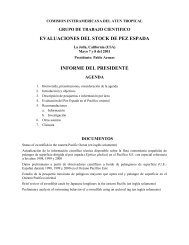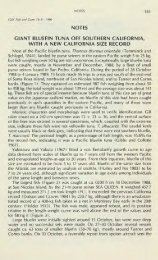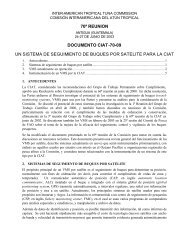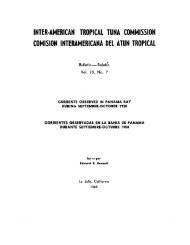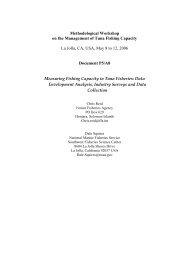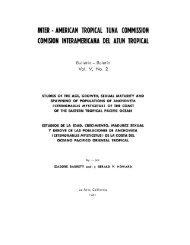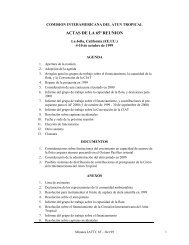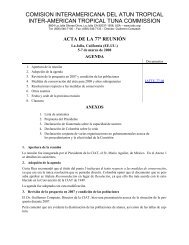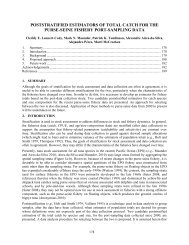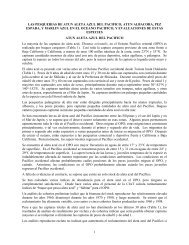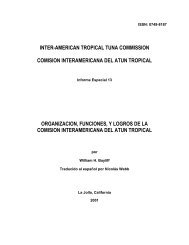IATTC Fishery Status Report 8 - Comisión Interamericana del Atún ...
IATTC Fishery Status Report 8 - Comisión Interamericana del Atún ...
IATTC Fishery Status Report 8 - Comisión Interamericana del Atún ...
You also want an ePaper? Increase the reach of your titles
YUMPU automatically turns print PDFs into web optimized ePapers that Google loves.
132<br />
general, however, the ocean inhabitants recover within short periods because their life histories are adapted to respond to a<br />
variable habitat.<br />
The <strong>IATTC</strong> reports monthly average oceanographic and meteorological data for the EPO, including a summary of current ENSO<br />
conditions, on a quarterly basis. The mild La Niña conditions that developed during the fourth quarter of 2008 continued into the<br />
first quarter of 2009. During the second quarter of 2009, the SSTs were mostly above normal and the depth of the thermocline<br />
increased. SSTs were all above normal during the third and fourth quarters of 2009. In December, 2009 the U.S. National Weather<br />
Service expected El Niño to ―exert a significant influence on the global weather and climate in the coming months.‖<br />
Variability on a decadal scale (i.e. 10 to 30 years) also affects the EPO. During the late 1970s there was a major shift in physical<br />
and biological states in the North Pacific Ocean. This climate shift was also detected in the tropical EPO by small increases in SSTs,<br />
weakening of the trade winds, and a moderate change in surface chlorophyll levels. Some researchers have reported another major<br />
shift in the North Pacific in 1989. Climate-induced variability in the ocean has often been described in terms of ―regimes,‖<br />
characterized by relatively stable means and patterns in the physical and biological variables. Analyses by the <strong>IATTC</strong> staff have<br />
indicated that yellowfin tuna in the EPO have experienced regimes of lower (1975-1982) and higher (1983-2001) recruitment, and<br />
possibly intermediate (2002-2006) recruitment. The increased recruitment during 1983-2001 is thought to be due to a shift to a<br />
higher productivity regime in the Pacific Ocean. Decadal fluctuations in upwelling and water transport are simultaneous to the<br />
higher-frequency ENSO pattern, and have basin-wide effects on the SSTs and thermocline slope that are similar to those caused by<br />
ENSO, but on longer time scales.<br />
There is evidence that the North Pacific Ocean is currently in a cool regime, while no such evidence is apparent for the equatorial Pacific.<br />
Environmental variability in the tropical EPO is manifested differently in different regions in which tunas are caught. For example,<br />
SST anomalies in the tropical EPO warm pool (5° to 20°N, east of 120°W) have been about one-half the magnitude and several<br />
months later than those in the equatorial Pacific NIÑO3 area (5°S to 5°N, 90° to 150°W).<br />
6. AGGREGATE INDICATORS<br />
Recognition of the consequences of fishing for marine ecosystems has stimulated considerable research in recent years. Numerous<br />
objectives have been proposed to evaluate fishery impacts on ecosystems and to define over-fishing from an ecosystem perspective.<br />
Whereas reference points have been used primarily for single-species management of target species, applying performance measures<br />
and reference points to non-target species is believed to be a tractable first step. Current examples include incidental mortality limits<br />
for dolphins in the EPO purse-seine fishery under the AIDCP. Another area of interest is whether useful performance indicators<br />
based on ecosystem-level properties might be developed. Several ecosystem metrics or indicators, including community size<br />
structure, diversity indices, species richness and evenness, overlap indices, trophic spectra of catches, relative abundance of an<br />
indicator species or group, and numerous environmental indicators, have been proposed. Whereas there is general agreement that<br />
multiple system-level indicators should be used, there is concern over whether there is sufficient practical knowledge of the<br />
dynamics of such metrics and whether a theoretical basis for identifying precautionary or limit reference points based on ecosystem<br />
properties exists. Ecosystem-level metrics are not yet commonly used for managing fisheries.<br />
New methods of ordination, developed by scientists at the Institute of Statistical Mathematics in Tokyo, Japan, have produced<br />
indices of association related to different groupings of catch and bycatch species for floating-object sets of the purse-seine fishery.<br />
The preliminary indices show clear large-scale spatial patterns, and relationships to environmental variables, such as SST,<br />
chlorophyll-a density, and mixed layer depth. Information on relationships between indices of species association and environmental<br />
characteristics may help to guide the development of approaches for bycatch reduction.<br />
Ecologically-based approaches to fisheries management place renewed emphasis on achieving accurate depictions of trophic links<br />
and biomass flows through the food web in exploited systems. The structure of the food web and the interactions among its<br />
components have a demonstrable role in determining the dynamics and productivity of ecosystems. Trophic levels (TLs) are used in<br />
food-web ecology to characterize the functional role of organisms, to facilitate estimates of energy or mass flow through<br />
communities, and for elucidating trophodynamics aspects of ecosystem functioning. A simplified food-web diagram, with<br />
approximate TLs, of the pelagic tropical EPO, is shown in Figure J-1. Toothed whales (Odontoceti, average TL 5.2), large squid<br />
predators (large bigeye tuna and swordfish, average TL 5.2), and sharks (average TL 5.0) are top-level predators. Other tunas, large<br />
piscivores, dolphins (average TL 4.8), and seabirds (average TL 4.5) occupy slightly lower TLs. Smaller epipelagic fishes (e.g.<br />
Auxis spp. and flyingfishes, average TL 3.2), cephalopods (average TL 4.4), and mesopelagic fishes (average TL 3.4) are the<br />
principal forage of many of the upper-level predators in the ecosystem. Small fishes and crustaceans prey on two zooplankton



